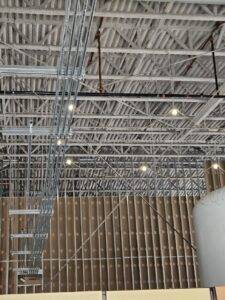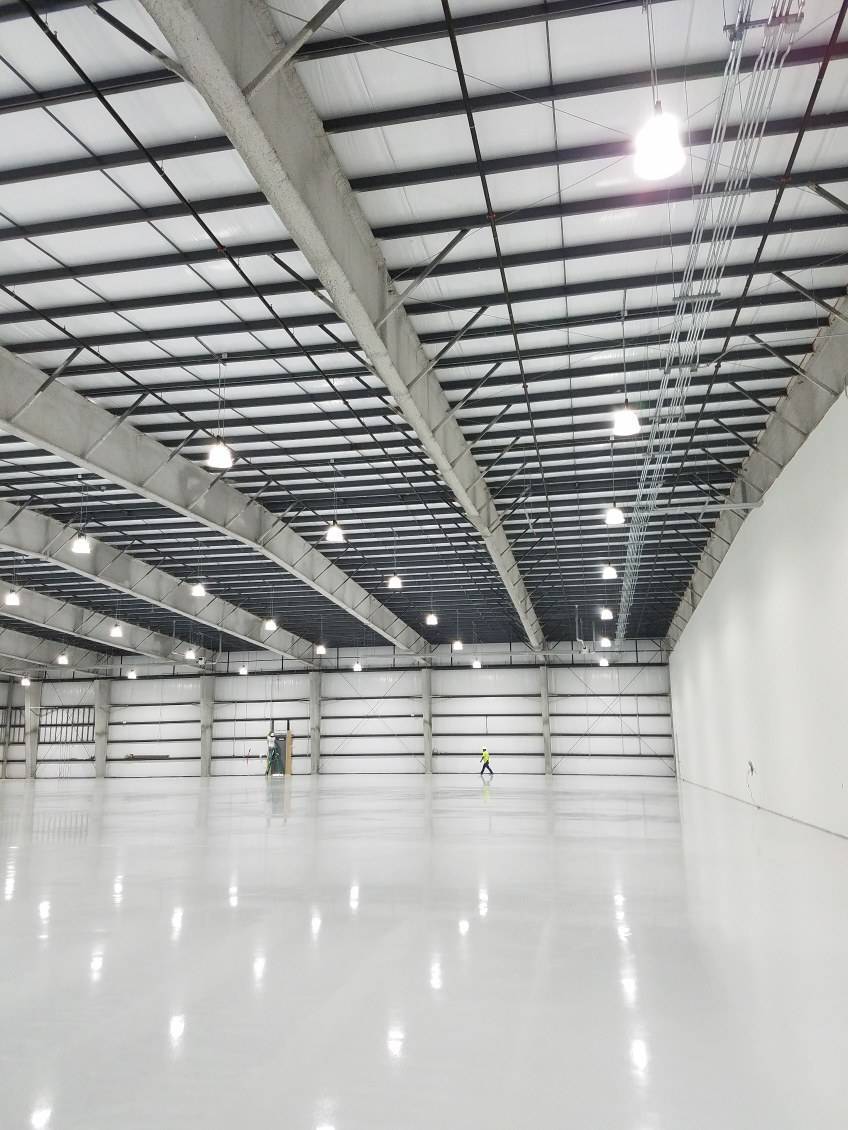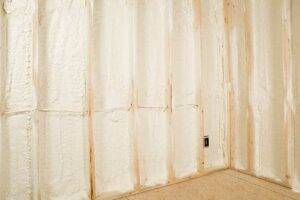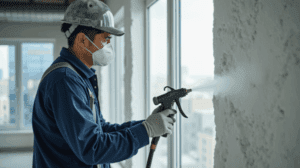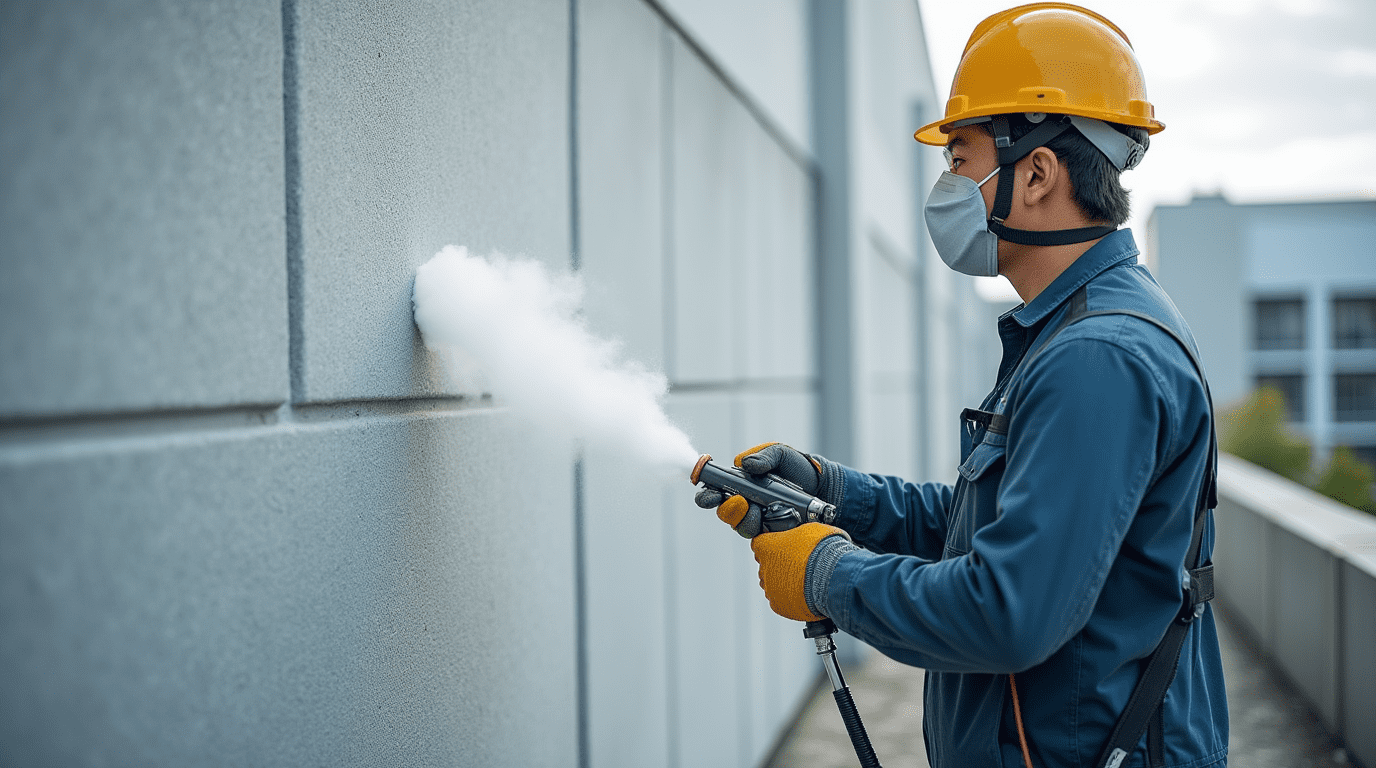Unlock Cost Savings with K-13 Insulation for Commercial Projects
Bahl Fireproofing
Commercial building owners constantly battle rising utility costs, maintenance headaches, and stricter energy codes. K-13 spray insulation addresses all three challenges in one application, delivering up to 30 percent reductions in heating and cooling expenses while simultaneously improving acoustic comfort and fire safety. This guide breaks down exactly how K-13 insulation generates measurable cost savings, enhances energy efficiency, controls noise pollution, and meets fire-resistance requirements across commercial facilities throughout Texas and the Midwest.
TLDR: K-13 spray insulation cuts commercial energy bills by 20-30 percent through seamless thermal coverage that eliminates gaps and thermal bridging. Its exceptional fire performance (flame spread 5, smoke developed 5, far exceeding Class A requirements), outstanding acoustic absorption (NRC 1.00-1.05 depending on thickness), and recycled cellulose composition (80% pre-consumer content) deliver fire protection, noise control, and sustainability in a single spray-applied system. Commercial projects typically achieve full ROI within two to five years through lower utility costs and reduced HVAC maintenance.
Why K-13 Makes Sense for Today’s Commercial Buildings
Steel decks and concrete substrates lose heat fast in winter and absorb it rapidly in summer. We’ve walked hundreds of commercial job sites where owners are paying premium HVAC bills because their thermal envelope has gaps at every joist and beam connection.
K-13 spray fiber insulation solves that problem by creating a continuous barrier that adheres directly to structural surfaces. No seams, no gaps, no thermal bridging. Just consistent R-value coverage that keeps conditioned air where it belongs.
The best part? You’re not choosing between thermal performance, acoustic control, and fire protection. K-13 delivers all three in one pass, which streamlines project schedules and eliminates the coordination headaches that come with installing multiple specialty systems.
How K-13 Insulation Reduces Energy Bills and Operating Costs
K-13 insulation cuts energy consumption by creating a complete thermal barrier that resists heat transfer and limits air infiltration. The material achieves an R-value of approximately 3.7 per inch, which may not sound dramatic until you see the actual utility data from buildings after installation.
The key mechanisms that drive energy savings include:
- Seamless adhesion that prevents gaps and eliminates thermal bridging at structural connections
- Cellulose fibers that trap microscopic air pockets for superior resistance to heat flow
- Condensation control that minimizes moisture-related HVAC loads and prevents hidden energy waste
These features translate into lower peak heating and cooling demands. Field data from commercial installations consistently shows 20 to 30 percent reductions in annual utility costs, typical for comprehensive insulation upgrades in previously under-insulated commercial buildings. The reduction in HVAC cycling also extends equipment life and lowers maintenance expenditures, which matters when you’re managing multi-year capital budgets.
Understanding K-13 Return on Investment
K-13 spray insulation delivers strong ROI through rapid payback periods and sustained savings over the building’s lifecycle. Installation costs typically range from $1.50 to $3.00 per square foot, depending on substrate type and coverage thickness requirements.
By reducing energy consumption and extending mechanical system life, commercial insulation projects typically recoup their K-13 investment in two to five years based on industry-standard performance data for thermal envelope improvements. The long-term financial benefits extend well beyond initial payback:
- Lower utility bills from reduced HVAC runtime and peak demand charges
- Fewer repair cycles due to controlled condensation and substrate protection
- Potential tax incentives for energy-efficient building upgrades under Section 179D
- Higher property valuations from improved energy performance certifications
Facility managers and building owners who track total cost of ownership find that K-13’s integrated approach (combining thermal, acoustic, and fire protection) delivers better economics than assembling multiple single-function systems.
How K-13 Reduces Long-Term Maintenance Costs
K-13 insulation reduces maintenance costs by providing Class A fire-resistant surface protection while minimizing substrate degradation over time. The cellulose fibers are factory-treated with fire-retardant additives that resist flame spread and smoke development according to ASTM E84 testing protocols.
It’s important to understand K-13’s role: this is thermal and acoustic insulation with excellent fire-resistant properties for exposed surfaces, not a replacement for structural fireproofing on steel beams and columns. For structural applications, K-13 is designed to be applied over spray-applied fire-resistive materials (SFRM) like Monokote or Cafco in UL-listed assemblies.
The maintenance and cost advantages K-13 provides include:
- Reduces coating complexity in assemblies where thermal, acoustic, and Class A surface fire resistance are needed for exposed decking and walls
- Limits corrosion under insulation through moisture management that prevents condensation on metal substrates
- Simplifies maintenance protocols by providing durable thermal and acoustic performance without requiring additional surface treatments or touch-ups
For metal deck assemblies, K-13 can be part of fire-rated systems when properly specified with structural fireproofing where required by code. This coordinated approach delivers both the thermal and acoustic control you need with the fire protection your project demands.
K-13 Thermal Performance and Energy Efficiency
K-13 insulation improves commercial energy efficiency by trapping thermal energy within building envelopes and reducing HVAC workloads throughout seasonal temperature swings. The open-cell structure captures air in microscopic fiber pockets, impeding both conductive and convective heat transfer.
The material exhibits an R-value of about 3.7 per inch and a vapor-permeable structure that prevents trapped moisture, a critical advantage in commercial applications where condensation can compromise both energy performance and structural integrity.
Key thermal properties that drive performance:
- High R-value per inch slows conductive heat flow through roof decks and wall assemblies
- Open-cell morphology manages humidity and prevents condensation without requiring separate vapor barriers
- Continuous coverage eliminates gaps and thermal bridges at joists, beams, and penetrations
These attributes allow HVAC systems to run at reduced capacity while maintaining consistent comfort conditions. Facility managers across our service areas report 25 percent decreases in compressor cycling and measurably longer equipment life, which translates to lower energy bills and deferred capital expenditures on mechanical system replacements.
By optimizing temperature regulation, commercial spaces experience more stable conditions and lower energy demand throughout both heating and cooling seasons, critical for meeting modern building codes and corporate sustainability commitments.
Acoustic Control Benefits for Commercial Environments
K-13 insulation provides exceptional acoustic benefits by absorbing airborne and impact noise through its open-cell structure. The material achieves impressive Noise Reduction Coefficient performance that varies by application thickness: 2 inches delivers an NRC of 1.00, while 1.5 inches on ribbed metal deck can reach NRC 1.05, providing highly effective sound absorption that significantly reduces reverberation and echo in occupied spaces.
This dramatic noise reduction improves sound quality in loud industrial environments and reduces reverberation in offices, schools, healthcare facilities, and multi-tenant commercial buildings. The acoustic control mechanisms include:
- Outstanding NRC performance that varies by thickness (1.0 to 1.05 for typical commercial applications), minimizing ambient background noise and eliminating echo
- Uniform coverage that blocks sound transmission through metal roof decks and structural assemblies
- Open-cell fiber structure that dampens impact noise and mechanical equipment vibration
Commercial environments with high ambient noise loads (manufacturing plants, gymnasiums, food-service kitchens) gain the greatest acoustic advantage from K-13 application. Educational facilities, healthcare centers, and corporate offices also benefit substantially from reduced chatter and echo, which promotes concentration and occupant well-being.
Acoustic control directly contributes to productivity by lowering background noise levels that cause auditory distraction and mental fatigue. Studies consistently link improved acoustic environments to increased focus and fewer communication errors. In commercial office settings, K-13 insulation can decrease sound pressure levels by up to 10 decibels, significantly enhancing employee satisfaction, collaboration effectiveness, and overall workplace performance.
Fire Resistance and Code Compliance
K-13 insulation offers reliable fire resistance through treated cellulose fibers that achieve Class A ratings for both flame spread and smoke development under ASTM E84 testing. The fire-retardant additives form a protective char layer when exposed to elevated temperatures, providing excellent surface fire resistance for exposed decking, walls, and ceiling applications.
K-13 significantly exceeds Class A requirements with actual test results showing flame spread of just 5 and smoke development of only 5, far superior to the Class A maximum thresholds of 25 and 50. These certifications ensure full adherence to International Building Code requirements for interior finishes across large-scale commercial construction projects.
It’s important to understand K-13’s role in fire protection: this material provides Class A surface fire resistance, making it ideal for exposed applications where thermal insulation, acoustic control, and fire-resistant finishes are required. For structural steel fireproofing (protection designed to prevent collapse during fires), dedicated spray-applied fire-resistive materials (SFRM) like Monokote or Cafco are required. K-13 is UL-listed for application over these structural fireproofing products in 15 different fire-rated assemblies, where it adds thermal and acoustic benefits to properly fire-protected structures.
According to ASTM E84 standards, properly applied spray fiber insulation can maintain fire-resistive surface performance for extended durations under standardized test conditions, providing measurable protection for building occupants and first responders.
Combined with its moisture-control properties, K-13 prevents corrosion under insulation over the building’s service life. For commercial projects requiring structural steel fireproofing, learn more about our intumescent fireproofing solutions. These specialized products are engineered specifically to protect steel beams and columns from collapse during fire events.
K-13 Compared to Other Commercial Insulation Systems
K-13 insulation compares favorably to mineral wool batts and rigid board options by delivering multifunctional performance (thermal resistance, acoustic absorption, and fire protection) in a single spray-applied material. Its seamless application ensures uniform coverage on complex geometries and irregular surfaces, unlike pre-cut panels that require careful fitting and leave gaps that must be sealed separately.
Cost Comparison of Commercial Insulation Options:
| Insulation Type | Installed Cost (per sq ft) | Core Benefits | Application Notes |
|---|---|---|---|
| K-13 Spray | $1.50 – $3.00 | Thermal, acoustic, fire | Seamless coverage on metal decks |
| Mineral Wool | $1.00 – $2.50 | Thermal, fire | Requires vapor barrier and sealing |
| Rigid Board | $2.00 – $4.00 | Thermal, structural | Panel seams need caulking and tape |
Performance Metrics Comparison:
| Metric | K-13 Spray (per inch) | Mineral Wool | Rigid Board |
|---|---|---|---|
| R-Value | 3.7 | 3.0 | 5.0 |
| NRC (Acoustic) | 1.00-1.05 | 0.70 | 0.10 |
| Fire Rating | Class A (5/5) | Class A | Class A |
| Moisture Management | Vapor permeable | Requires barrier | Requires barrier |
K-13 outperforms alternatives by delivering an R-value of 3.7 per inch alongside exceptional acoustic absorption, achieving NRC values of 1.00 to 1.05 depending on application thickness. Mineral wool offers comparable thermal resistance but significantly lower sound-dampening capability (NRC around 0.70). Rigid board systems provide higher R-values per inch but negligible acoustic control and require meticulous seam sealing to prevent thermal bridging.
Projects with large open spans (warehouses, manufacturing facilities, gymnasiums) benefit most from K-13’s seamless spray application. Renovations in occupied office buildings gain acoustic and thermal improvements with minimal disruption to ongoing operations. Multi-story parking garages and cold storage facilities leverage K-13’s condensation control and fire-resistive properties, making it a versatile solution across diverse commercial sectors.
Real-World Cost Savings and Performance Data
K-13 insulation delivers measurable energy reductions and maintenance savings in actual commercial applications. Industry data for comprehensive insulation upgrades demonstrates 25 to 30 percent energy savings across varied climate zones. A documented case from Kansas City International Airport shows K-13 performing reliably after 18 years of service, confirming its long-term durability in demanding commercial environments.
Field installations report substantial acoustic improvements. A school renovation project experienced noise levels decrease by 8 decibels, substantially enhancing classroom acoustics and reducing teacher vocal strain. A hospital wing addition achieved Class A fire rating compliance while recording significant reductions in peak energy demand during summer cooling months.
Key performance metrics for K-13 commercial installations:
- Energy Reduction: 20 to 30 percent lower HVAC consumption, typical for comprehensive insulation upgrades in commercial buildings
- Acoustic Improvement: NRC values of 1.00 to 1.05 depending on thickness, reducing ambient noise by 8 to 12 decibels
- Fire Compliance: Exceptional Class A performance with flame spread 5 and smoke developed 5 under ASTM E84 testing
- Payback Period: Two to five years for typical commercial applications based on industry-standard thermal envelope improvement data
These quantifiable outcomes demonstrate K-13’s financial and performance advantages across real commercial construction and renovation projects throughout Texas, Kansas, and Oklahoma.
Bahl Fireproofing’s Professional K-13 Installation Process
Professional K-13 installation ensures uniform coverage, regulatory compliance, and project efficiency through systematic surface preparation and application protocols. Certified applicators follow manufacturer specifications to deliver consistent thermal, acoustic, and fire-resistive performance across commercial projects.
The K-13 spray application process:
- Surface Preparation: Structural decks and walls are cleaned and primed to ensure proper adhesion and long-term performance
- Material Application: Certified technicians spray the cellulose-fiber formulation at specified thicknesses (typically 1.5 to 2.5 inches) using calibrated equipment for uniform density
- Quality Inspection: Thickness measurements and density testing verify compliance with thermal resistance, acoustic absorption, and fire-rating requirements
- Documentation: Detailed reports confirm that all performance specifications are met before project close-out
Bahl Fireproofing maintains quality and compliance through rigorous installer training, adherence to ICC specifications, and documented inspection protocols. All technicians hold current industry certifications, and material applications undergo systematic testing to meet ASTM standards for thermal, acoustic, and fire performance.
Our systematic approach guarantees that every K-13 installation delivers the energy savings, acoustic control, and fire protection that commercial building owners expect, backed by documentation that satisfies code officials and insurance underwriters.
Frequently Asked Questions
What types of commercial buildings benefit most from K-13 insulation?
K-13 insulation works exceptionally well in commercial buildings with large open spaces, including warehouses, manufacturing plants, distribution centers, and gymnasiums. The spray-applied nature allows effective coverage on complex geometries and makes it ideal for renovations in occupied buildings where minimal disruption matters. Multi-story parking structures, cold storage facilities, schools, healthcare centers, and corporate offices all leverage K-13’s combined thermal, acoustic, and fire-resistive properties.
How does K-13 insulation contribute to green building certifications?
K-13 supports LEED certification and other green building standards through its composition of 80 percent pre-consumer recycled cellulose fibers and energy-efficient performance. By optimizing thermal resistance, it reduces energy consumption and lowers greenhouse gas emissions over the building’s lifecycle. The material’s non-toxic fire retardants and sustainable composition align with corporate environmental goals and increasingly strict energy codes.
What maintenance does K-13 insulation require over time?
K-13 is designed to be low-maintenance due to its durable cellulose fiber composition and moisture control properties. Regular visual inspections during routine building maintenance confirm the insulation remains intact and free from damage. Unlike traditional systems, K-13 minimizes corrosion under insulation through condensation control, eliminating a major source of hidden degradation and costly repairs.
Can K-13 be applied in existing buildings during renovations?
Yes, K-13 works well for retrofit applications in existing commercial buildings. The spray-applied method conforms to various surfaces and fills gaps effectively, creating a seamless thermal and acoustic barrier. Application can often proceed while spaces remain partially occupied, minimizing business disruption. Proper surface preparation and adherence to installation guidelines ensure optimal performance in renovation projects.
What is the expected lifespan of K-13 insulation?
K-13 insulation provides reliable performance for 20 years or more when properly installed and maintained. The durable cellulose fibers and fire-retardant treatments resist environmental degradation. Regular inspections help identify any localized damage from mechanical work or roof leaks, allowing targeted repairs that extend effective service life. This durability makes K-13 a cost-effective long-term investment.
How does K-13 insulation affect indoor air quality?
K-13 positively impacts indoor air quality by controlling moisture and reducing conditions that promote mold growth. Its vapor-permeable structure manages humidity without trapping moisture that can degrade air quality. The cellulose fibers are treated with non-toxic fire retardants that don’t release harmful chemicals into occupied spaces, making K-13 a safe choice for commercial facilities focused on occupant health and comfort.
How long does K-13 installation take for a typical commercial project?
Installation timeframes depend on project size and access conditions. A 50,000 square foot roof deck application typically takes three to five days including surface prep, spraying, and inspection. Larger projects or complex geometries may require additional time. Our team provides detailed scheduling during the bid process to ensure K-13 application integrates smoothly with your overall construction timeline.
Does K-13 require special HVAC considerations during installation?
Yes, HVAC systems should be temporarily shut down during K-13 application to prevent overspray from entering ductwork. Our installers coordinate with mechanical contractors to protect equipment and ensure air handling units remain clean. Once the material cures (typically 24 to 48 hours), HVAC operation resumes normally with no long-term impacts on system performance.
Key Takeaways
- K-13 spray insulation cuts commercial energy bills by 20 to 30 percent through seamless thermal coverage that eliminates gaps and thermal bridging at structural connections
- The material exceeds Class A fire requirements with exceptional test results (flame spread 5, smoke developed 5) while delivering outstanding acoustic control (NRC 1.00 to 1.05 depending on thickness) and thermal efficiency (R-3.7 per inch) in a single application
- Commercial insulation projects typically achieve return on investment within two to five years through combined utility savings and reduced HVAC maintenance costs
- K-13’s 80 percent pre-consumer recycled content supports LEED certification and corporate sustainability goals while meeting stringent fire safety codes
- Professional installation by certified applicators ensures consistent performance and regulatory compliance across large-scale commercial construction
- Retrofit applications work effectively in occupied buildings, providing thermal, acoustic, and fire protection with minimal disruption to ongoing operations
Ready to Reduce Your Commercial Building’s Operating Costs?
If your next project demands insulation that delivers measurable energy savings, superior acoustic control, and code-compliant fire protection (all in one application), let’s discuss how K-13 can improve your building’s performance and bottom line. Our team brings 20 years of fireproofing and insulation expertise to commercial projects throughout Texas, Kansas, and Oklahoma. Contact Bahl Fireproofing today to schedule a consultation or request a detailed project bid.
Disclaimer: This article provides general educational information about fireproofing and insulation systems and does not constitute professional engineering advice or product specification. System selection must be based on project-specific fire ratings, thermal requirements, acoustic performance needs, environmental conditions, substrate requirements, and budget constraints. Code requirements vary by jurisdiction and project type. Always consult with a licensed professional and verify UL or FM assembly listings before finalizing specifications.

